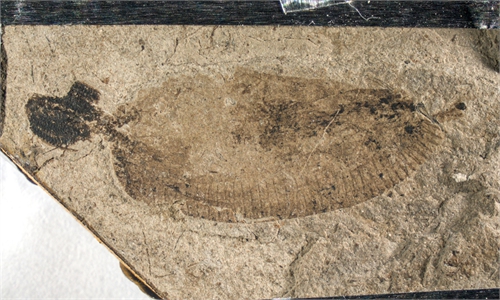ARTS / CULTURE & LEISURE
Newly discovered fossil in Hubei could advance gradual marine mass extinction hypothesis

Photo: screenshot
For the first time, a giant alatoconchid bivalve fossil has been discovered by researchers in Central China's Hubei Province, offering crucial new evidence for understanding one of Earth's major marine mass extinction events, as reported by the China News Service.
A team from the paleontological fossil research center under the Hubei Institute of Geosciences made the discovery in the Maokou Formation strata of Jingmen city.
"It marks a significant addition to the regional fossil record and sheds light on a dramatic extinction event that occurred at the end of the Middle Permian," Wu Kui, the leader of the paleontology team as well as the deputy director of the research center, told the Global Times on Wednesday.
The fossil belongs to a now-extinct group of shelled marine organisms known as alatoconchid bivalves. These creatures featured broad, flat, wing-shaped shells with distinctly different inner and outer textures that could grow up to one meter in length. Prior to this discovery, such fossils had only been found in Yunnan, Guizhou, Guangxi, and Jiangxi in China.
Wu noted that though the Hubei specimens show no significant morphological differences compared to similar findings in Yunnan, the importance of the Hubei discovery lies in its contribution to the geographical distribution record, indicating that this group was already widely distributed across shallow marine environments in South China during the Middle Permian.
Researchers recovered shell fragments around 15 centimeters in length from sites in the Duodao district and Jingshan city. Through detailed comparisons of shell layering, prismatic textures, and hinge grooves, the fragments were confirmed to belong to a giant bivalve species. The fossil layer is approximately 1.5 meters thick.
The bivalve fossils were found alongside those of brachiopods, ammonites, and corals, indicating these species once coexisted in a warm, shallow marine environment. Notably, these fossils disappear in the overlying layers, suggesting that the organisms were wiped out during a sudden environmental crisis, likely linked to massive volcanic activity that drastically altered ocean conditions.
The discovery provides a new perspective on marine biodiversity and ecological stress during the Permian. The team also plans to carry out carbon and oxygen isotope analysis, along with trace element testing, to reconstruct ancient ocean conditions. If significant isotopic disturbances or elemental enrichment patterns are present, they may indicate regional climate fluctuations, sea level changes, or volcanic activity.
"If further analysis reveals signs such as body-size reduction, population decline, or shell chemistry disturbances, it could support the hypothesis that extinction was a gradual process driven by escalating pressures rather than a sudden event, Such evidence would offer vital biological validation for the 'volcano-temperature-hypoxia' cascade model," Wu said.
In the future, the research team plans to expand their work into western sections of Hubei, particularly in Yichang and Enshi, where the Middle to Upper Permian strata are well-developed and hold high potential for paleontological studies.
At the same time, the newly discovered "pre-extinction ecological snapshot" will serve as valuable material for basic scientific research. It also has great educational value and can help young learners better understand ancient marine environments in their original form.
Efforts are also underway to develop fossil-based field teaching programs, study tours, and an outcrop museum with the aim of transforming the region into a national geoscience education hub for primary and secondary school students.



